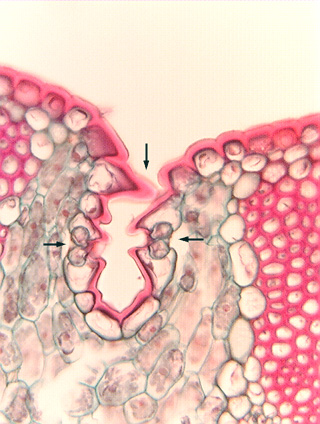 Fig.
10.3-16. Magnification of yucca leaf. In this
section of the groove, two stomata are visible (horizontal arrows); other
sections often have three or four. The epidermis is not papillose for the most
part, but there is a single bulging cell (vertical arrow) that partially blocks
the opening of the groove (because it is a long groove, a single bulging cell
will not block it completely). As with the crypts in oleander leaves, the air in
this groove will be fairly calm, and if a water molecule diffuses out of one
stoma here, there is a good chance it might just diffuse into the other one. Having
the stomata restricted to grooves enhances water conservation.
Fig.
10.3-16. Magnification of yucca leaf. In this
section of the groove, two stomata are visible (horizontal arrows); other
sections often have three or four. The epidermis is not papillose for the most
part, but there is a single bulging cell (vertical arrow) that partially blocks
the opening of the groove (because it is a long groove, a single bulging cell
will not block it completely). As with the crypts in oleander leaves, the air in
this groove will be fairly calm, and if a water molecule diffuses out of one
stoma here, there is a good chance it might just diffuse into the other one. Having
the stomata restricted to grooves enhances water conservation.